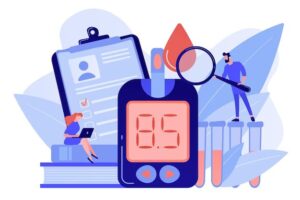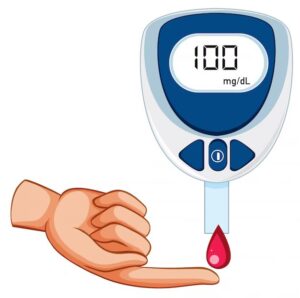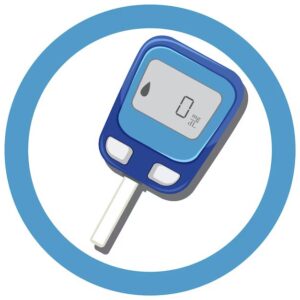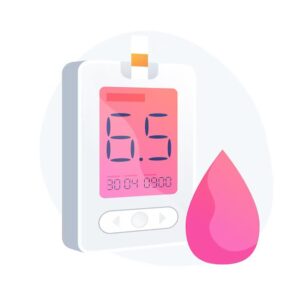The majority of the food you eat is converted by your body to sugar (glucose), which is subsequently released into your bloodstream. For blood sugar to reach your body’s cells and give them energy, insulin is necessary. Unfortunately, having diabetes causes your body to create too little or use it incorrectly.
Due to low insulin levels or cells that no longer respond to insulin, too much blood sugar remains in your bloodstream. This may eventually result in serious health problems like heart disease, kidney disease, and vision loss.
Blood Sugar Levels: A Quick Summary
Extremely high blood sugar levels (far more than 300 mg/dL) may, in extreme situations, result in coma.
High blood sugar is defined as 180 to 250 mg/dL. Blood sugar levels of more than 250 mg/dL or less than 50 mg/dL are dangerous and require prompt medical care.
Blutdruck Chart
To preserve their health and prevent complications, diabetics must understand their blood sugar levels. Knowing your blood sugar levels can also be beneficial for people who do not yet have a diabetes diagnosis because it may enable you to take appropriate action for undetected what level of blood sugar is dangerous?
The following are some typical blood sugar ranges:
Is Having Low Blood Sugar Dangerous?
The body’s main energy source is sugar, also referred to as glucose.
The medical word for when your blood sugar levels fall below the usual range is hypoglycemia. A blood glucose test is the only way to diagnose low blood sugar, despite the fact that low blood sugar can induce a variety of symptoms.
Diabetes medication is one of the most frequent reasons of low blood sugar. When a person develops type 1 diabetes, their pancreas is unable to produce insulin anymore. The use of high insulin dosages or oral diabetic medications can also lead to hypoglycemia.
Contrary to popular belief, low blood sugar can happen even when your body is producing more insulin than is deemed healthy. It’s not just a symptom of diabetes, either.Alcohol consumption combined with anti-diabetic drugs can result in hypoglycemia.
When your blood sugar levels are too low, your cells run out of energy. Simple symptoms like hunger and headaches may be the first ones to appear. If you don’t quickly raise your blood sugar levels, you could run serious hazards.
To avoid hypoglycemia or high blood sugar levels, you need to take the right amount of insulin. On the other hand, if you use too much insulin, your blood sugar will drop quickly.
5 Quick Ways to Lower Blood Sugar Levels
1) Workout
Exercise effectively and swiftly decreases blood sugar levels. Your blood sugar may stay lower for up to 24 hours after exercising out. This is also due to the fact that it makes your body more sensitive to insulin.
Because of this, the body requires glucose to function when exercising. Consequently, blood sugar levels frequently drop as a result of the muscles absorbing glucose from the cells.

You must perform an exercise that raises your heart rate. For instance, cycling and brisk walking are both beneficial exercises. Importantly, if your blood sugar is higher than 240 mg/dl, you should check your urine for ketones.
If ketones are present, you should avoid activity and first seek medical attention.
If you have type 1 diabetes, your doctor will undoubtedly urge you to check your blood sugar before working out. Home urine ketone testing kits are available.
You can control your blood sugar levels throughout the day by exercising. However, certain types of exercise, particularly quick bursts of intensive activity, may momentarily increase them. Additionally, physical exertion triggers the stress response in the body, which releases glucagon to fuel the muscles.
2) Intake of Carbs
The amount of carbs you eat has a big effect on your blood sugar levels. This is also due to the fact that your body turns carbohydrates into simple sugars, primarily glucose.

When you consume too many carbohydrates or your body produces less insulin, this process is slowed down, and your blood glucose levels may rise.
By doing this, you may better plan your meals and improve blood sugar regulation. A low-carb diet reportedly lowers blood sugar levels and helps prevent blood sugar rises.
You can still eat some carbohydrates while monitoring your blood sugar. The nutritious content of whole grains is superior to processed grains and refined carbohydrates, and they also lower blood sugar levels.
3) Intake of Fibre
By delaying the digestion of carbohydrates and the absorption of sugar, it encourages a more gradual increase in blood sugar levels.

Both are important, but soluble fibre mostly aids in blood sugar regulation whereas insoluble fibre does not. A diet high in fibre can therefore improve your body’s ability to control blood sugar and lower blood sugar levels. You might be able to better control type 1 diabetes as a result.
Vegetables, fruits, and legumes are some foods high in fibre. The USDA recommends a daily fibre intake of 25 grammes for women and 38 grammes for men.
4) Water intake
By getting enough water, you may be able to keep your blood sugar levels in check. Regular water drinking before a meal may reduce fasting blood sugar levels, according to study.

Keep in mind that one of the healthiest drinks is water. Drinks with added sugar should be avoided as they can raise blood sugar levels, lead to weight gain, and increase the chance of developing diabetes.
5) Checking Blood Sugar Ranges
By routinely checking your blood sugar levels, you can better control them. This can be done at home with a CGM.
With regular tracking, you can determine whether you need to alter your diet or medication. It also explains to you how your body reacts to certain foods. Additionally, regular blood sugar monitoring may be more advantageous than a one-time practise.

If a meal causes your blood sugar to spike, a HealthifyPRO2.0 CGM can help you decide whether you should make modifications to it rather than completely forego it. Reducing portion sizes and incorporating more non-starchy vegetables are two examples of adjustments.
Note by TheHealthkeet
Diabetes is a chronic condition that requires ongoing observation and quick treatment. Diabetes patients must maintain blood sugar levels within the normal range because both hypoglycemia and hyperglycemia can be harmful. Maintaining blood sugar levels requires a diet high in fibre, enough water consumption, and the correct exercise programme.
Conclusion
High blood sugar arises when your body can’t use the insulin it does make or doesn’t produce enough of it. By taking insulin, you can lower your blood sugar levels.
Ask your doctor how much rapid-acting insulin you should take when your blood sugar is high. Additionally, if you frequently have extreme highs or lows in your blood sugar levels, talk to a healthcare professional about modifying your diabetes treatment plan.
Disclaimer: The sole goal of this article is to share information and raise awareness.



